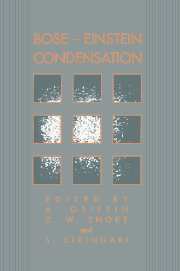Book contents
- Frontmatter
- Contents
- Preface
- Preface to paperback edition
- 1 Introduction: Unifying Themes of Bose–Einstein Condensation
- Part one Review Papers
- Part two Brief Reports
- 20 BEC in Ultra-cold Cesium: Collisional Constraints
- 21 BEC and the Relaxation Explosion in Magnetically Trapped Atomic Hydrogen
- 22 Quest for Kosterlitz–Thouless Transition in Two-Dimensional Atomic Hydrogen
- 23 BEC of Biexcitons in CuCl
- 24 The Influence of Polariton Effects on BEC of Biexcitons
- 25 Light-Induced BEC of Excitons and Biexcitons
- 26 Evolution of a Nonequilibrium Polariton Condensate
- 27 Excitonic Superfluidity in Cu2O
- 28 On the Bose–Einstein Condensation of Excitons: Finite-lifetime Composite Bosons
- 29 Charged Bosons in Quantum Heterostructures
- 30 Evidence for Bipolaronic Bose-liquid and BEC in High-Tc Oxides
- 31 The Dynamic Structure Function of Bose Liquids in the Deep Inelastic Regime
- 32 Possibilities for BEC of Positronium
- 33 Bose–Einstein Condensation and Spin Waves
- 34 Universal Behaviour within the Nozières–Schmitt-Rink Theory
- 35 Bound States and Superfluidity in Strongly Coupled Fermion Systems
- 36 Onset of Superfluidity in Nuclear Matter
- Appendix. BEC 93 Participant List
- Index
26 - Evolution of a Nonequilibrium Polariton Condensate
Published online by Cambridge University Press: 15 December 2009
- Frontmatter
- Contents
- Preface
- Preface to paperback edition
- 1 Introduction: Unifying Themes of Bose–Einstein Condensation
- Part one Review Papers
- Part two Brief Reports
- 20 BEC in Ultra-cold Cesium: Collisional Constraints
- 21 BEC and the Relaxation Explosion in Magnetically Trapped Atomic Hydrogen
- 22 Quest for Kosterlitz–Thouless Transition in Two-Dimensional Atomic Hydrogen
- 23 BEC of Biexcitons in CuCl
- 24 The Influence of Polariton Effects on BEC of Biexcitons
- 25 Light-Induced BEC of Excitons and Biexcitons
- 26 Evolution of a Nonequilibrium Polariton Condensate
- 27 Excitonic Superfluidity in Cu2O
- 28 On the Bose–Einstein Condensation of Excitons: Finite-lifetime Composite Bosons
- 29 Charged Bosons in Quantum Heterostructures
- 30 Evidence for Bipolaronic Bose-liquid and BEC in High-Tc Oxides
- 31 The Dynamic Structure Function of Bose Liquids in the Deep Inelastic Regime
- 32 Possibilities for BEC of Positronium
- 33 Bose–Einstein Condensation and Spin Waves
- 34 Universal Behaviour within the Nozières–Schmitt-Rink Theory
- 35 Bound States and Superfluidity in Strongly Coupled Fermion Systems
- 36 Onset of Superfluidity in Nuclear Matter
- Appendix. BEC 93 Participant List
- Index
Summary
Abstract
We review the theory of the polariton condensate taking into account exciton–exciton interactions.
It is known [1] that coherent electromagnetic radiation resonant with an isolated exciton energy level excites in the crystal a coherent polariton wave with the wave vector ko ≠ 0 — the non-equilibrium polariton condensate. Different scattering processes accompanying its propagation lead to the loss of the initial coherence of the polariton wave, complete or partial depletion of the condensate, excitation of polaritons with wave vector k ≠ 0, and other phenomena.
In the present paper the effect of exciton–exciton scattering processes on the properties of a coherently excited polariton system are discussed. This scattering mechanism is of considerable interest due to recent experimental investigations [2] and many interesting results (see e.g. Refs. [3, 4]) obtained in theoretical study of dynamic and kinetic processes in a system of interacting polaritons.
According to Refs. [4, 5], exciton–exciton scattering is very important when coherent polaritons are excited in a certain spectral region in which energy and momentum conservation laws allow real processes of two-quantum excitation of polaritons from the condensate. These processes lead to the instability of the condensed state of the polariton system. The existence of this spectral region situated around the isolated exciton resonance is due to the peculiarities of the polariton dispersion relation.
In [5] the energy spectrum of non-condensate polaritons, arising as the result of decay of the coherent polariton wave, is studied.
- Type
- Chapter
- Information
- Bose-Einstein Condensation , pp. 513 - 518Publisher: Cambridge University PressPrint publication year: 1995



